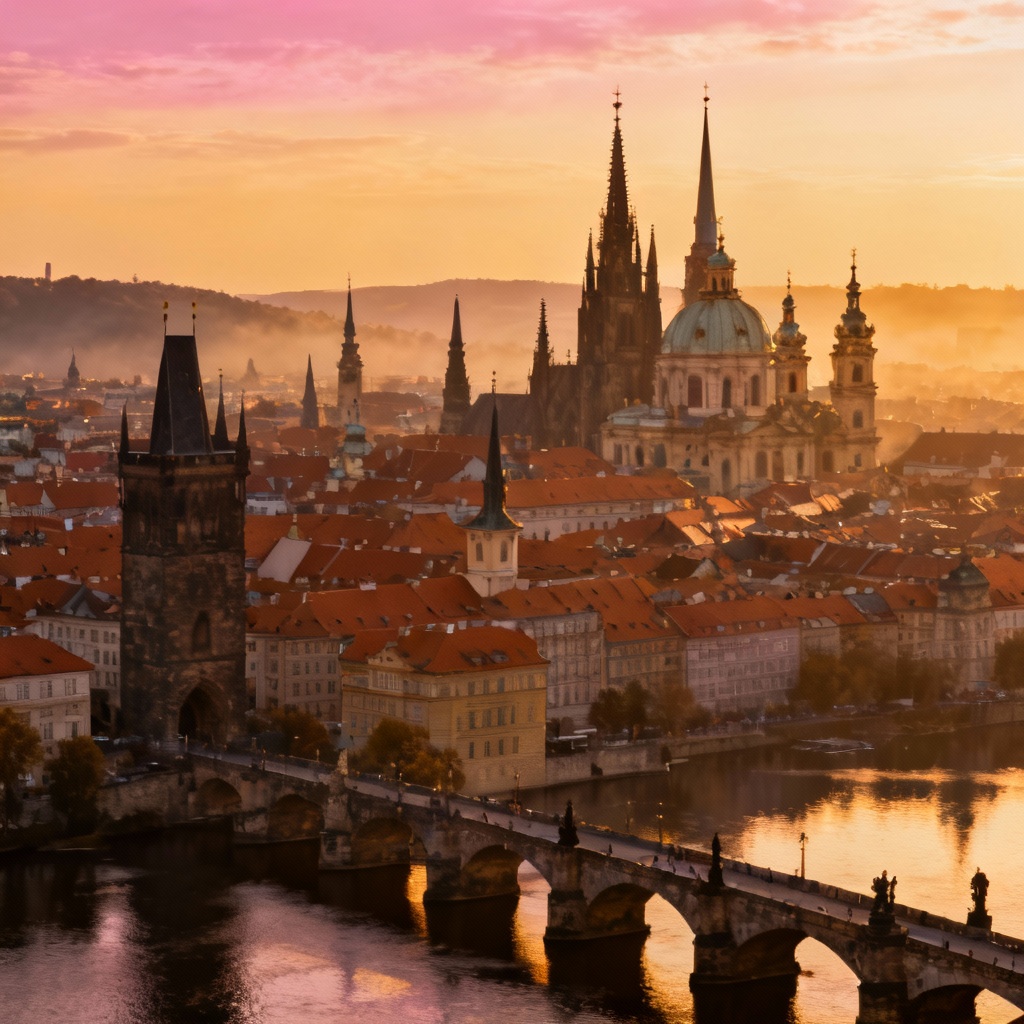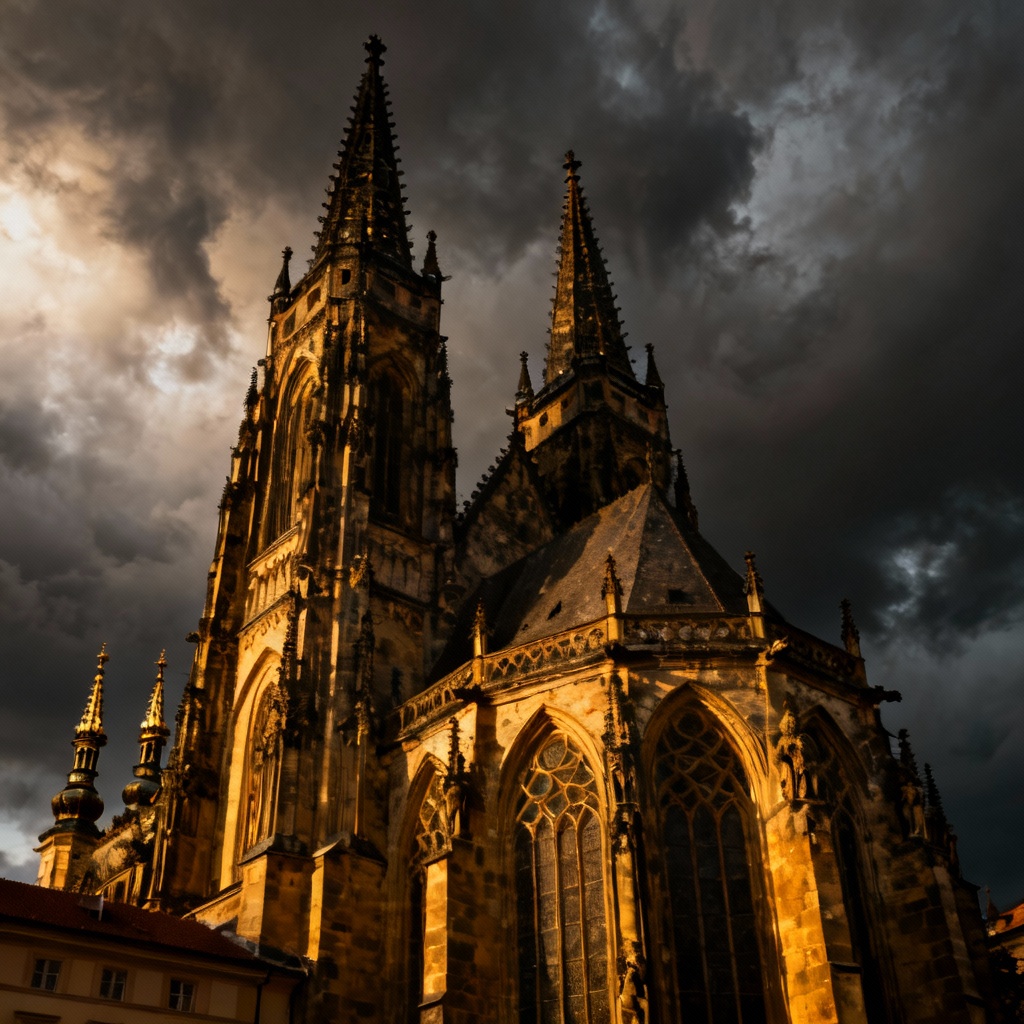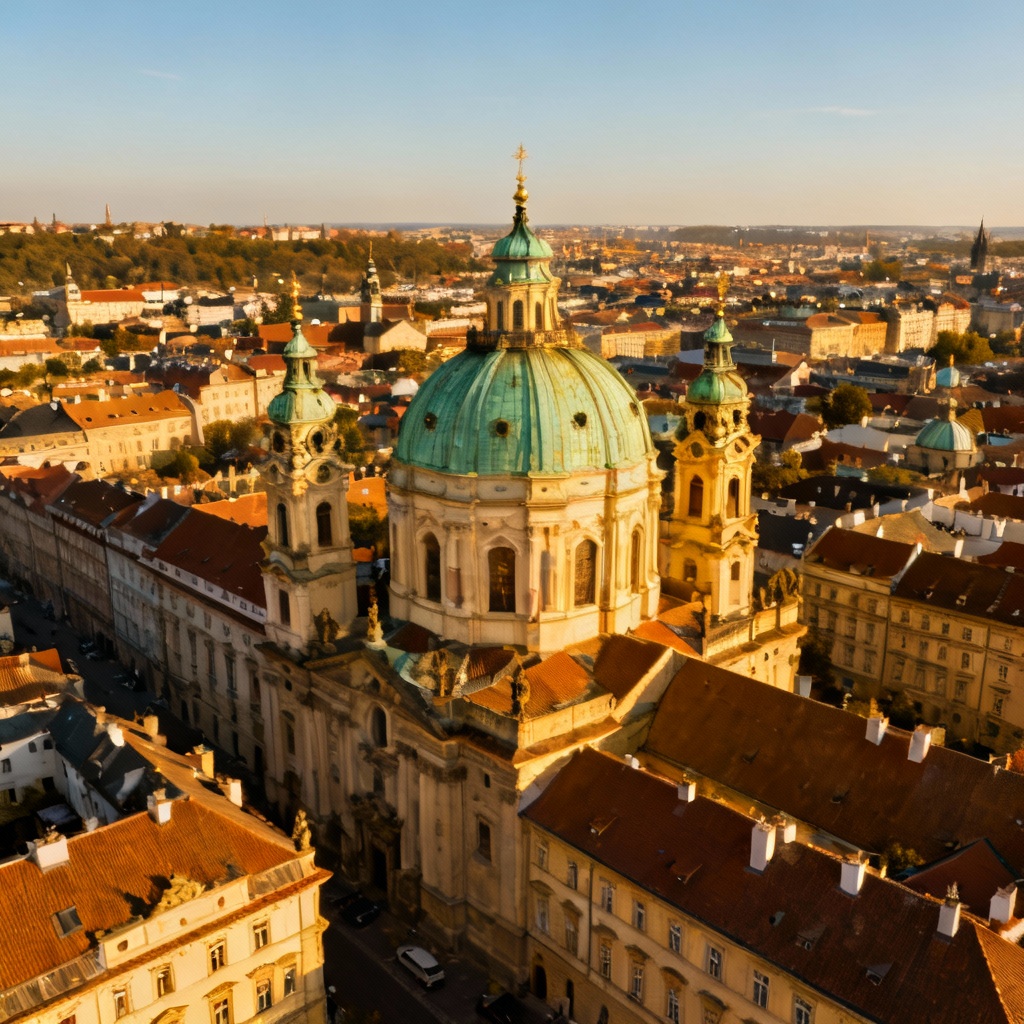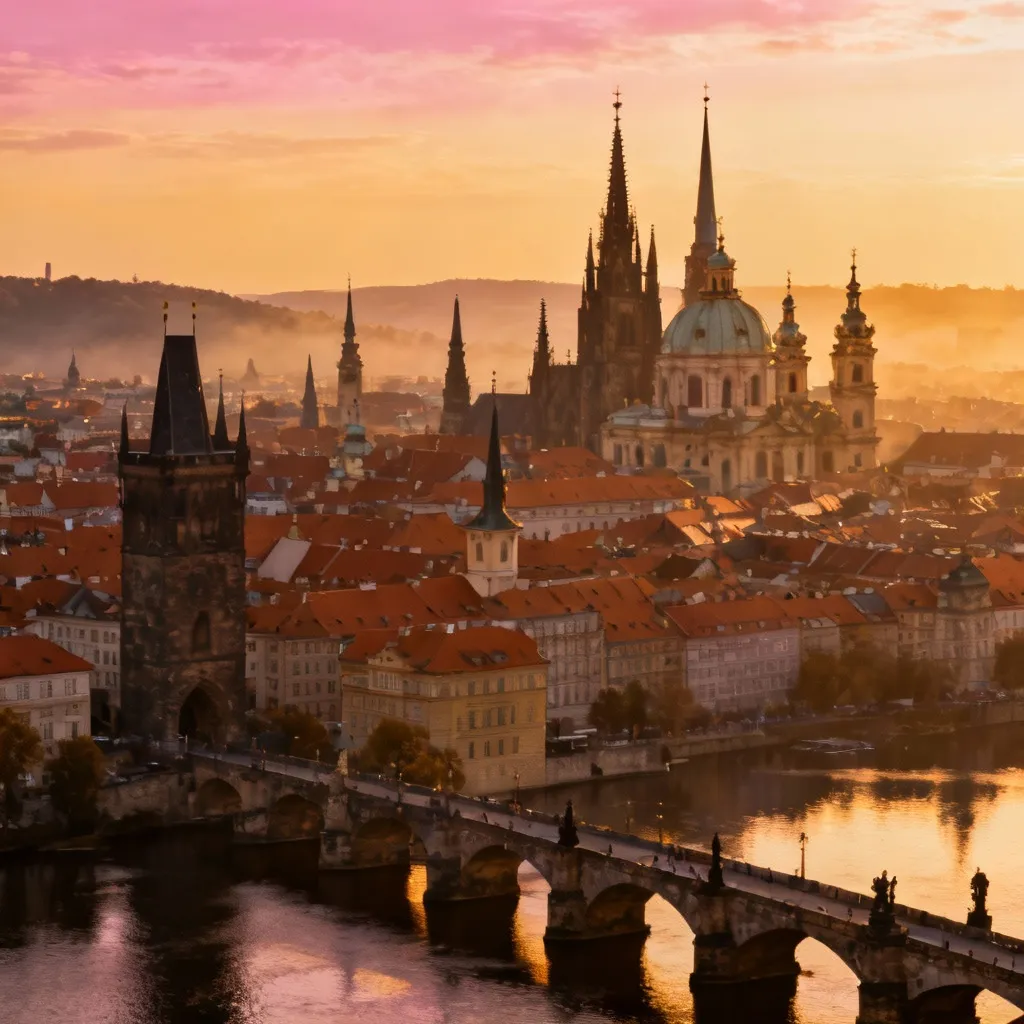Why Prague is Called the City of a Hundred Spires: A Look at Czech Culture and Architectural History
A panoramic vista of Prague is not just a view; it is a medieval dreamscape cast in stone, where every skyline element fights for the eye's attention. From the heights of the hill-capping Prague Castle, one looks out upon an overwhelming sea of rooftops pierced by countless Gothic, Renaissance, and Baroque architectural punctuations. These aren't simple roofs or towers; they are domes of copper and gold, lancet-arched bell towers, and razor-sharp, intricate steeples that paint a portrait of vertical aspiration against the sky.
The enduring moniker that captures this visual spectacle is the "City of a Hundred Spires." It is a charming phrase, yet a fundamentally misleading one in purely mathematical terms, hinting at a truth far deeper than a simple tally. To call Prague the City of a Hundred Spires is to use an elegant synecdoche, where the beautiful and profound essence of the capital's unique architectural culture is represented by an unforgettable image. Understanding the real meaning behind this nickname requires exploring the very foundations of Czech history and the fascinating origins of an architectural legend.
Introduction: The Enduring Nickname of the Czech Capital
The title, 'City of a Hundred Spires' (Stověžatá Praha in Czech), conjures an image of almost mythical quality, suggesting a place that consciously curated its vertical landscape to dazzle and inspire. Visitors to Prague quickly realize that the official count has been dwarfed by centuries of tireless construction. Even without trying, the profusion of decorative points and peaks scattered across the old city’s landscape appears to far exceed a mere hundred.
The discrepancy between the quaint title and the modern reality is intentional and lies at the heart of the city's identity. The name is not meant to be a census result, but a poetic description of a deeply spiritual and artistically rich metropolis that flourished as a capital for the Bohemian Kingdom and the Holy Roman Empire. The term itself is an acknowledgment of a history built upward, where every spire and tower reflects a powerful moment in Czech history, faith, or prosperity.
This article will trace the origins of this legendary nickname back to a precise count from the 19th century. We will then traverse the great architectural periods, from the monumental foundations of the Gothic era that birthed the first and most imposing towers, to the theatrical flair of Baroque Prague that gilded them in gold and added ornate domes. By the end, the simple 'hundred' will reveal itself as the perfect, immortal symbol of Prague’s eternal culture.
The Origin Story: Bernard Bolzano's 19th-Century Count
The credit for giving Prague this universally recognized, enduring nickname can be attributed directly to a Bohemian intellectual of the 19th century, although others contributed to its spread. The famed mathematician, philosopher, and Catholic priest, Bernard Bolzano, took it upon himself in the early 1800s to make an actual census of the city's towering structures.
It was Bolzano's calculation that fixed the number at 103, a figure based on counting the towers and spires he deemed prominent enough within the old core of the city. While Austrian historian Josef Hormayr is often also credited with using a similar descriptive title around the same time, it was the scholarly rigor, or perhaps simply the precise nature of Bolzano’s work that solidified the number as a cultural fact. His detailed count offered tangible proof to a phrase that had likely existed colloquially for centuries.
This detailed cataloging arrived at a time when the Czech lands were beginning a strong push for national pride and identity, emerging from under the political and cultural shadows of the greater Austrian Empire. A descriptive, almost folkloric name like "The City of a Hundred Spires" served as a powerful tool. It celebrated the city's architectural grandeur and historical legacy in a way that resonated far beyond academic circles.

The number "one hundred," in many languages and cultures, carries symbolic weight, suggesting a complete or innumerable collection, far more than an exact, quantifiable amount. The "103" from Bolzano's careful study quickly morphed into the round, alliterative, and far more poetic 'City of a Hundred Spires.' This subtle linguistic shift allowed the number to transcend mere historical accounting, transforming it into an unforgettable, catchy symbol. Thus, the nickname became an immortal label for a magnificent cityscape, representing every structure that jutted proudly into the sky.
Gothic Majesty: The Iconic Towers That Defined the Skyline
The genesis of Prague’s spire-heavy skyline is undeniably rooted in the medieval era and the revolutionary architectural achievements of the Gothic architecture style. This era was characterized by a push towards verticality—a literal and symbolic striving for heaven—achieved through pointed arches, flying buttresses, and tall, tapered spires that visually anchored the entire city. The most profound examples of this are situated on and around Prague Castle and the Old Town Square.
The Crown of the Castle: St. Vitus Cathedral
Dominating the Hradčany district, the monumental St. Vitus Cathedral (Cathedral of Saints Vitus, Wenceslaus and Adalbert) stands as the singular most important expression of Czech Gothic ambition. Its construction, initiated by Charles IV in 1344 and guided by masters like Peter Parler, was a multi-century effort, culminating only in 1929.
The cathedral’s massive bulk is punctuated by its primary towers. The spectacular main or Great South Tower, which reaches an impressive height of approximately 102.8 meters, commands attention as the single tallest tower in the complex. Conversely, the Western façade is famously flanked by two imposing front towers that stand roughly 82 meters tall, forming a powerful, unmistakable silhouette from all river viewpoints. Every finial, arch, and spire on the cathedral contributed countless minor points to the overall spire count, making St. Vitus an architectural universe in itself—an unmissable feature of the City of a Hundred Spires. A key practical tip for visitors is to climb the Great South Tower for an unparalleled panoramic perspective on the density of the Prague skyline and all the spires beyond.
The Old Town’s Gothic Sentinels: The Church of Our Lady before Týn
The quintessential postcard image of Prague's Old Town Square is not complete without the imposing presence of the Church of Our Lady before Týn (Týn Church). Its towering twin spires soar over the houses clustered around its base, an arrangement that emphasizes their incredible height and dark, dramatic aesthetic.
Constructed over the 14th and 15th centuries, this building became the religious and symbolic center for the Hussite movement, an early proto-Protestant movement critical to Czech national identity. Its spires, reaching an imposing height of 80 meters, possess a distinctive feature: each one is capped not just by a single spire but by a complex structure that includes eight smaller spires clustered around the main pinnacle.
These spires illustrate another fascinating Gothic quirk—they are asymmetrical, with the southern tower being noticeably larger and taller than the northern one. This disparity, sometimes referred to as the 'male and female' tower design, was a subtle yet deliberate feature often used in the Gothic architecture of the time, providing a metaphor for the distinct elements within the medieval body of Christ or the human world. The Týn Church remains the darkest and perhaps most visually dramatic entry in Prague’s repertoire of spires, its menacing facade a testament to centuries of fervent belief and turbulent Czech history.

More Gothic Landmarks on the Vltava
The Gothic mastery that shaped Prague extended well beyond the major church buildings. The Powder Gate (Prašná brána), a magnificent late Gothic architecture tower, was built in 1475 as a ceremonial gateway and served as the starting point for royal coronation processions. Today, it forms a dramatic link between the Old Town and the New Town, offering visitors another opportunity to climb for a high-up view.
Furthermore, the famous Charles Bridge is flanked by two distinct, ornate Gothic towers: the Old Town Bridge Tower, an exceptionally sculpted gateway on the Old Town side, and the smaller but equally old bridge towers guarding the Malá Strana approach. The sheer number and height of these functional and religious towers across the Vltava river, many of which owe their existence to the vision of Charles IV and his court architects, is what cemented Prague’s reputation long before Bolzano arrived.
The Evolution of Spires: From Renaissance Domes to Baroque Grandeur
The historical evolution of Prague's architectural culture ensures that the 'hundred spires' are not a monotonous collection of single style. Instead, the cityscape evolved across centuries of shifting artistic movements, adding layers of stylistic contrast. While the High Gothic cathedrals reached the dizzying peaks of austerity, subsequent eras contributed softer domes, exuberant turrets, and gilded pinnacles.
The period following the Hussite Wars and the onset of the Habsburg rule saw a transition towards Renaissance influences. Although a calmer period architecturally, the spires from this time often appear more grounded, and many churches introduced simple, clean, non-pointed domes and small decorative turrets that contrast sharply with the vertical thrust of the earlier Gothic style. Examples of this blend are found across the city, as new elements were added to existing medieval structures.
The Exuberance of Baroque Prague: St. Nicholas Church
The true explosion of alternative skyline shapes came with the magnificent Counter-Reformation in the 17th and 18th centuries, bringing the lavish, theatrical style of the Baroque era. Nowhere is this Baroque Prague influence better illustrated than in the Church of St. Nicholas in Malá Strana (Lesser Town), considered by many to be the greatest example of the High Baroque north of the Alps.
This imposing church was built by the father-and-son team of Christoph and Kilian Ignaz Dientzenhofer between 1704 and 1755, replacing the site’s earlier Gothic structure. St. Nicholas in Malá Strana is defined by its soaring, massive dome and its separate, 79-meter-tall belfry. Unlike the Gothic period’s thin, stone-latticed spires, Baroque structures used voluminous copper domes and thick, twisting spires that are often painted green and topped with glistening gold crosses. They introduced a sense of opulence and dynamic movement to the cityscape.
Inside the church, visitors find themselves beneath a spectacular ceiling fresco and surrounded by rich stucco decorations, a testament to the comprehensive Baroque vision that sought to create an emotional, overwhelming spiritual experience. The fusion of the dynamic Baroque lines with the medieval foundations of the surrounding city only reinforced Prague’s unique, diverse architectural culture.
Noteworthy Tower Additions
Beyond the colossal church architecture, a myriad of other vertical structures also feeds the Prague legend. The Old Town Bridge Tower, mentioned before, is an essential historical sentinel on the Charles Bridge, built by the prolific Peter Parler’s workshop in the mid-14th century. It stands not only as an entrance but as a spectacular symbolic arch through which Czech kings traveled on their coronation route.
A less historic but equally significant contributor to the current spire count is the Petřín Lookout Tower. Built for the Jubilee Exhibition in 1891, this steel lattice structure is essentially a miniature copy of the Eiffel Tower, providing the city with one of its highest, secular vantage points. Looking down from the Petřín Tower on the countless historic structures emphasizes how thoroughly the skyline is dominated by centuries of religious and civil history. The varied types of prague towers—from defensive battlements to flamboyant decorative spires—illustrate an unmatched history of architectural preservation.

Beyond One Hundred: The Real Count and Cultural Significance Today
The fact remains that Bolzano’s century-old count, even with its mathematical precision of 103, no longer reflects the true state of Prague’s incredible skyline. The nickname is now merely a beautiful, archaic shorthand.
The Modern Tally
According to contemporary estimates from sources like the Prague Information Service, the number of identifiable towers and major spires within the historic areas of the city is well over 500. This figure includes church towers, spires, turrets, monumental gates like the Old Town Hall Tower, and other substantial decorative pinnacles that define the Old Town and Lesser Town. Should a person be tempted to count every tiny, ornate finial and decoration on top of apartment blocks and smaller buildings across the greater city area, the number could well surpass a thousand. The current 500+ figure serves as a staggering testament to the continuity of Prague’s urban development.
Resilience and the National Identity
The enduring power of the "City of a Hundred Spires" nickname stems largely from the city’s ability to preserve its historical form across centuries of upheaval. Unlike many European capitals that suffered extensive damage during the two World Wars and subsequent modern rebuilding efforts, Prague emerged relatively intact. This historical resilience allowed the medieval, Gothic architecture core to survive alongside the magnificent Baroque additions, creating the unique layering of history visible today.
This spectacular blend of architectural epochs—from the Romanesque remnants and monumental St. Vitus Gothic lines to the opulent Baroque Prague aesthetic—is what makes the city a jewel box of central European architecture. The visual continuity of this grand heritage is a pillar of Czech national identity, standing as a proud and unvanquished symbol of continuity.
Prague: A UNESCO World Heritage Site
It is this incomparable architectural legacy that earned the entire historic center of Prague its rightful place on the UNESCO World Heritage list in 1992. UNESCO specifically cites the blending of ten centuries of artistic influences and its exceptional universal value. The density and sheer variety of the towers are a tangible expression of Prague’s cultural and political history.
The nickname acts as an essential draw for Prague tourism, giving the city an immediate, romantic, and historically grounded appeal. Tourists are actively encouraged to appreciate the skyline from various vantage points, seeking out the perfect perspective on what is, in reality, the City of Five Hundred Spires.
Actionable Tips for Spire Spotting:
- View from Above: Climb the Old Town Hall Tower, the Powder Gate, or the Petřín Lookout Tower for comprehensive, detailed views that help distinguish the various architectural styles (Gothic, Renaissance, Baroque).
- The Vltava View: Stroll the Charles Bridge for a magnificent eye-level panorama, catching St. Vitus in the distance and the Týn Church framed in the nearer background.
- Perspective Shift: For a classic, sweeping Baroque Prague vista, stand by the Old Town Bridge Tower and look across the river toward the dome of the Church of St. Nicholas.
- Trek a Hill: Take the funicular up Petřín Hill for a classic high-angle view that demonstrates the incredible density of the spires emerging from the red-roofed buildings below.
Conclusion: The Immortal Symbol of Prague's Charm
The title "Why Prague is Called the City of a Hundred Spires" poses a simple question with a rich, multifaceted answer rooted in mathematics, poetry, and a unique national story. The truth is that the nickname, born of a factual 19th-century tally by Bernard Bolzano, swiftly became something far greater than its component numbers.
It is the architectural conversation across the ages, defined by the breathtaking verticality of Gothic architecture like the twin spires of the Týn Church and the dramatic majesty of St. Vitus, then harmoniously countered by the fluid, opulent domes of Baroque Prague like St. Nicholas, that grants the city its fame. The ‘hundred’ acts not as a measure of quantity but a profound statement of quality.
Ultimately, the ‘City of a Hundred Spires’ remains the quintessential name for the Czech capital because it encapsulates an unforgettable visual and a deep historical truth. It captures the imagination and speaks to a centuries-old culture of aspiring upward, giving Prague an ethereal, timeless charm. Looking up at its towering silhouettes at dusk, every visitor understands instinctively that they are witnessing one of the world’s great, immortal architectural spectacles.
